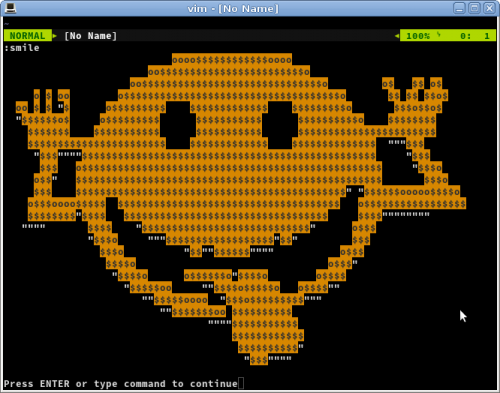Here is one feature of Vim you probably didn’t know about – “:smile” command.

Here’s the patch, via Hacker News.
Linux is my primary operating system. I used it on the servers, desktops, laptops, netbooks, and even mobile phones since approximately 1997. I’ve tried a number of distributions over the years, and even created a couple myself. I still look around sometimes to see what others are up to. But most of my machines are running some sort of Red Hat – either a quick and easy Fedora Linux, or a stable and secure Red Hat Enterprise Server, or a cheaper CentOS alternative.
And while by now I am very comfortable in the Linux environment (both graphical and command line), I still discover a lot of new and interesting things about it. When I come across something worthy, I usually share it with the rest of the Open Software world, using this category.
Here is one feature of Vim you probably didn’t know about – “:smile” command.

Here’s the patch, via Hacker News.
I’ve just upgraded my laptop to Fedora 25. The upgrade process was a breeze (as per instructions from this article):
sudo su - dnf upgrade --refresh dnf install dnf-plugin-system-upgrade dnf system-upgrade download --releasever=25 dnf system-upgrade reboot
About 2,500 packages (1 GB and some) were downloaded in about 40 minutes (yeah, our Internet connection could use a boost). Then rebooted and the upgraded kicked in. It took about another 40 minutes to run the process (I should get myself an SSD-based laptop next time).
The only thing I had to fix after the upgrade was the kmod-wl package, which provides the drivers for my wireless interface. Another reboot later all was good.
There were no major visual changes (I’m using MATE Desktop), but something felt a bit different. After focusing on the differences for a few minutes, I think it’s the fonts. Something is better, sharper, more polished.
Other than that, all is pretty much the same. I’ll need to use it for a while to see if I can spot any changes. Hopefully, at least a flickering issue that I got after some upgrade during the Fedora 24 life span is fixed now. It was weird. A particular application window would start to flick and refresh until clicked again. Never figured out what it was. :)

It’s a well known fact that I am not the greatest fan of Microsoft and their technologies. I’ve been bitten many a time through the years. And not even them becoming a Platinum Partner in the Linux Foundation can change my attitude towards them. It’s just been too much pain, and scars, and tears, and sweat.
But the way life is, once in a while, I just have to work with or around them. Recently, for example, at work, we’ve done a project that just had to use MS SQL Server and there was no way to get around it. Gladly, I managed to find just the right image on the Amazon AWS Marketplace, and spin a new EC2 instance for testing. The local development was difficult, but at least we had a place to test stuff before sending it off to the customer.
If such a need arises in the future, I think I’ll give the MS SQL for Linux a try. And that’s when this article from Fedora Magazine might come in handy. MS SQL + Docker + Fedora. Hmm.
This article – “Using Ansible to Bootstrap My Work Environment Part 4” is pure gold for anyone trying to figure out all the moving parts needed to automate the provisioning and configuration of the Amazon EC2 instance with Ansible.
Sure, some bits are easier than the other, but it takes time to go from one step to another. In this article, you have everything you need, including the provisioning Ansible playbook and variables, cloud-init bits, and more.
I’ve printed and laminated my copy. It’s on the wall now. It will provide me with countless hours of joy during the upcoming Christmas season.
After our recent MySQL migrations, I started getting a weird issue – Zabbix server process was crashing periodically (several times a day).
8395:20161109:175408.023 [Z3005] query failed: [2013] Lost connection to MySQL server during query [begin;] 8395:20161109:175408.024 [Z3001] connection to database 'zabbix_database_name_here' failed: [2003] Can't connect to MySQL server on 'zabbix_database_host_here' (111) 8395:20161109:175408.024 Got signal [signal:11(SIGSEGV),reason:1,refaddr:(nil)]. Crashing ...
Digging around for a bit, it seems like a widely reported issue, related Zabbix server using the same database connection as one of its agents is monitoring (here is an example bug report).
Not having enough time to troubleshoot and fix it properly, I decided for the time being to use another monitoring tool – monit – to keep an eye on the Zabbix server process and restart it, if it’s down. After “yum install monit“, the following was dropped into /etc/monit.d/zabbix:
check process zabbix_server with pidfile /var/run/zabbix/zabbix_server.pid
start program = "/sbin/service zabbix-server start" with timeout 60 seconds
stop program = "/sbin/service zabbix-server stop"
Start the monit service, make sure it also starts at boot, and watch it in action via the /var/log/monit:
[UTC Nov 20 20:49:18] error : 'zabbix_server' process is not running [UTC Nov 20 20:49:18] info : 'zabbix_server' trying to restart [UTC Nov 20 20:49:18] info : 'zabbix_server' start: /sbin/service [UTC Nov 20 20:50:19] info : 'zabbix_server' process is running with pid 28941
The chances of both systems failing at once are slim, so I think this will buy me some time.